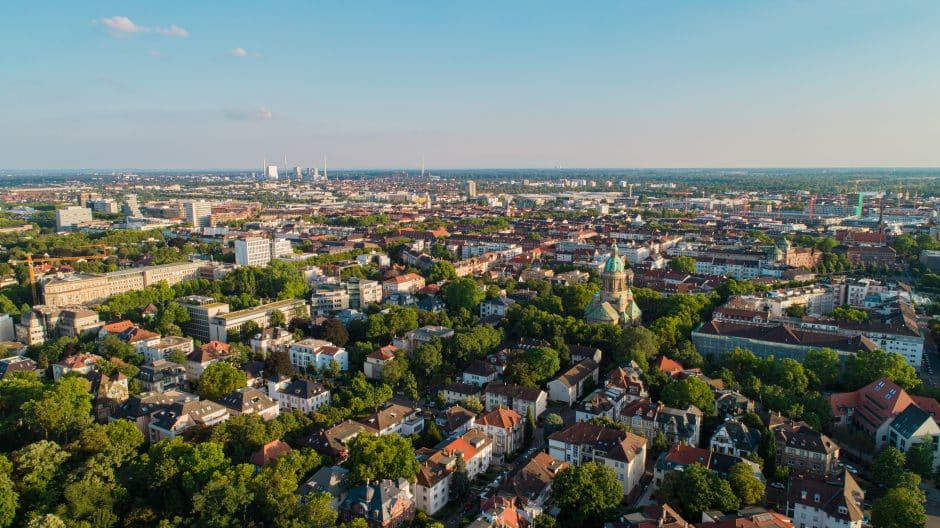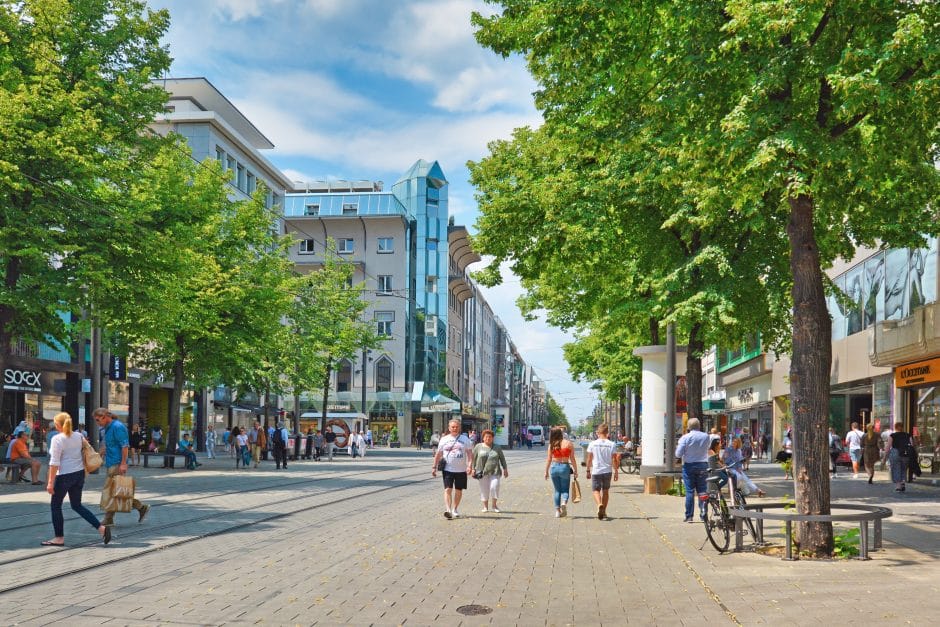How Mannheim is Unlocking Citizen-Empowered Transformation
In The News
30 Aug 2024
Mannheim, Germany, once the cradle of transportation innovation, is now pedalling towards a different future—one of climate neutrality. The city is tapping into a new resource, its citizens. Through an innovative ‘House of Change’, Mannheim is helping citizens unlock the doors to their sustainable future, taking into account their priorities, preferences, and lifestyles. This is the story of how a city famous for putting the world on wheels is now leading the charge towards a citizen empowered climate transition.
In 1817, Baron Karl von Drais raced through the streets of Mannheim on a wooden frame with wheels, a world-first that he called a ‘Laufmaschine’ or ‘running machine’, in English, but better known to us now as the bicycle. In 1885, the city saw the birth of a more advanced form of transport with the first automobile, in the form of a three-wheel motor vehicle. Its inventive energy continued, pioneering the electric elevator and the world’s first rocket-powered aircraft. Backed by its innovation credentials, Mannheim played an important role in Germany’s industrialisation, and is home to the second-largest coal-fired power plant in the country.
Today, Mannheim is the cultural and economic centre of the Rhine-Neckar Metropolitan Region, and Germany’s seventh-largest metropolitan area with nearly 2.4 million inhabitants. It has remained an important centre of progression, home to world-class academic institutions like the University of Mannheim. It’s innovative ecosystem and good infrastructure have made it an international business hub.
Mannheim is building on its industrial past for a new age. It was the first German city with a heat action plan that includes vulnerable groups. Thirty percent of its district heating network is powered by renewable energy, and it now aims to extend this to 75%. The city is well known to climate actors for their local implementation of policies like the EU Green Deal and Sustainable Development Goals. In 2022, Mannheim was selected by the European Commission to be part of the EU Mission to deliver 100 climate-neutral and smart cities by 2030, delivered by the platform led by EIT Climate-KIC: NetZeroCities.
The CoLAB Pilot
According to Agnes Schönfelder, Spokesperson for the EU Green Deal at the City of Mannheim, the main challenges the city faces when it comes to reaching climate neutrality are greening the heating and electrical systems, increasing renewable energy uptake, and decarbonising the transport system.
“One of our main challenges is mobility: Mannheim is where the car was invented, but also the bicycle and the elevator. So, we have a legacy of innovation in mobility, and we have a good public transport system that has made Mannheim a 15-minute city. But our city is designed for cars, as are many others in Europe, so it’s really hard to have few cars in the city centre,” says Schönfelder.
Joining the EU Mission and designing their Climate City Contract – essentially the city’s roadmap for reaching climate neutrality – prompted Schönfelder and colleagues in the city administration to reflect on what is required to reach the ambitious target. Schönfelder has long realised the importance of involving citizens:
“…for a long time, I’ve thought that we need to address citizen behaviour change, and how to bring their voice into our work towards systems transformation. Simply giving them funding is not the key. So, the idea to focus on citizen behaviour in consumer-related emissions was born, and we address this in the Pilot Cities Programme, with the idea of helping them make their city liveable, green, healthy, and climate-neutral by 2030.”
From this idea came partnership building. Mannheim brought two other major German cities on board, Aachen and Muenster. Well-known scientific partners who can provide expert knowledge from social and behavioural science, environmental and climate research, communication and participation, project design, and monitoring and visualization, were also brought on board: the ifeu Institute Heidelberg, Creative Climate Cities and wechange from Berlin, Swiss Scaling4Good and the Swedish Climate View. Mannheim’s Climate Action Agency brings in expertise in civic action, environmental education and communication.
Together, they form the ‘CoLAB – Committed to Local Climate Action Building’ Pilot Activity, in which radical collaboration is taking shape within and between cities, as partners bring residents into their cities’ climate plans.
The project joins together a portfolio of strategic plans and experiments that will enable the cities and their partners to test approaches to reducing emissions from consumer behaviour – emissions that the city cannot directly impact. As well as reducing emissions, the project aims to test how citizens participate in processes and develop solutions to improve individual and collective well-being, and to involve citizens as peers in co-creating a more sustainable future.

The Seven Doors of Change
At the centre of the CoLAB project is a platform that connects all actors, from the city administration to companies and citizens, and inspires and mobilizes them to act sustainably: the ‘House of Change’.
“The idea of the House of Change is to recognise the fact that there is so much going on in every city. There are so many players involved in sustainability, mobility, green infrastructure, biodiversity and so on. But they are not connected to each other. And citizens don’t always know what they can do . That’s why we decided to create an online space where all this is connected: Information, advice, challenges, events and exhibitions, spaces to meet and more.
At the House of Change, people can find help and answers to their questions. More than 80% of our citizens say that they want to live more sustainably, but they find it difficult to go further. They need skills, they need knowledge, they need incentives and, above all, they need optimism and simple, easy-to-implement measures,” says Schönfelder.
There are seven doors in the virtual House of Change. Each door represents access to a more sustainable lifestyle. A key is required for each door. If you find out who has the key and how to open the door, you can find the solution for sustainable decisions. Two or more doors can be unlocked at the same time. This example of playful implementation of climate protection measures promotes understanding of system change and rewards environmentally friendly practices. Citizens, businesses, universities, the city: all players are co-creators in the House of Change, and the House of Change is a game for multiple players, but it must be transferred to the real world to effect change.
As a citizen ‘visiting‘ the House of Change, you will get an overview of what is happening in the city under the umbrella of sustainability. You may learn about a specific challenge where incentives (such as free public transport) are exchanged for sustainable choices (such as taking the bus instead of driving). You may also learn about an event where a sustainable model apartment is shown, helping consumers make informed choices regarding their own households.
Beyond the flagship platform, Aachen is setting up a 2030 Climate Agency and a physical entry point to the House of Change, and Muenster is designing a digital tool in the form of an app that supports people in making climate-friendly decisions.
“We really dived deep into the research around behaviour change and decision making to design the Pilot. People make decisions every second of their lives, from the time they get up in the morning, to the kind of shampoo they use, to whether they decide to use their car or take the bus. So, it was important to understand this, understand how and when people are making the decisions that can impact emissions, and how the city can simplify the way for the decisions that result in lower emissions,” explains Schönfelder.

The city administration as a facilitator of systemic transformation
To Schönfelder, change starts with people – not cars. “Before implementing technical changes in our city, or asking people to make climate-conscious lifestyle choices, governing authorities need to get to know their citizens.”
In her experience, citizen engagement means more than asking citizens to change – it means putting people at the centre of policy, and understanding the values and norms that make up their behaviour. The CoLAB project has taken much of its shape from academic and scientific inquiry into these subjects. It has also been specifically designed to include feedback loops so cities and their partners can learn from the project.
“For each experiment, we draw up an overview of the target groups, the participants, the relevant stakeholders and the results. In the example of reducing car traffic, one target group may be parents who take their children to school, commute to the office, go shopping and engage in leisure activities. Who among them uses their private car? Who other than the municipality can provide the tools for a change in mobility? In this case, it is the public transport companies that can offer a good, attractive infrastructure and fares. Change is about asking questions. By asking them systematically and measuring and tracking the results, we can build up a picture. And that’s what we do with every experiment. This helps us to create better regulations and incentives that can facilitate a change in behaviour,” describes Schönfelder.
Mannheim understands that each interaction, project, workshop, citizen consultation, and campaign is an essential opportunity for yielding insights into who the citizens of Mannheim are, and this is what sets the city apart. This picture is becoming increasingly nuanced and has enabled the city to question and build awareness of what the city’s role is in the climate transition, vis-a-vis citizens. According to Agnes Schönfelder, an essential part of that role is that of facilitator.
“The feeling we have at the moment is really electric. So many people are interested in what we are doing, and it’s so rewarding to show Mannheim as a modern city administration capable of taking positive steps with our citizens. And the most important thing the city can do is simplify the way,” says Schönfelder.
Mannheim has another year in the Pilot Cities Programme in which they will continue to develop the CoLAB project and the House of Change. Moving away from the old ways and towards a systemic view of a climate-neutral city is challenging, but if the inventive DNA that saw the creation of the bicycle, car and elevator is anything to go by, their future is exciting.
Its priorities are certainly clear. When it comes to reaching climate neutrality, citizens must be involved, and sustainable change must be a collaborative endeavour.
This article is part of EIT Climate-KIC’s #LiveableCities Campaign, where we explore the pathways to a climate neutral, just, and more beautiful future. By 2030, our goal is to help transform over 400 cities into thriving, climate-resilient communities. This campaign captures the stories and lessons of ambitious cities in Europe and around the world. We want to show a vision of what’s possible when cities and stakeholders come together to tackle the climate crisis.



